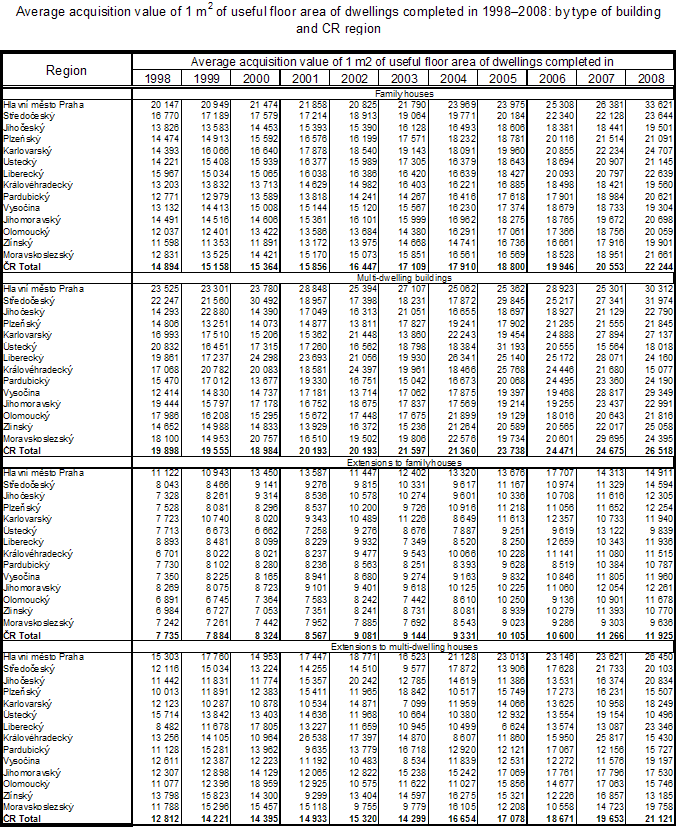Analysis of the housing construction in the Czech Republic - in 2008
Publication Date: 20. 05. 2009
Product Code: w-8215-09
1. Summary
Starting and completing of dwellings
- 43 531 dwellings were started (down by 0.6% against 2007);
- 38 380 dwellings were completed (down by 7.8%);
- 176 123 dwellings were under construction on 31 December 2008.
Acquisition value
- the acquisition value of residential buildings completed in 2008 reached CZK 91.5 billion;
- acquisition value per dwelling was CZK 2 411.7 thousand (up by 14.9% compared with 2007);
- acquisition value per m2 of living floor area was CZK 31.7 thousand (up by 6.5%).
Amenities
- electricity and water supply coverage is considered 100% and is not observed;
- over 84% of dwellings completed in 2008 were connected to a central heating system (local or long-distance heating);
- more than half of the new family houses were connected to the sewerage network (67.7%).
Length of construction period
- the average construction period of a residential building decreased by 1.3% compared with 2007 and took 39.3 months;
- compared to multi-dwelling buildings, construction period for family houses and extensions thereto was markedly longer; approx. 14% of family houses were being built more than 5 years.
Dwelling size
- average living floor area per dwelling grew by 8.0% against 2007 and reached 76.0 m2;
- average useful floor area per dwelling was 107.0 m2 (up by 8.4%);
- the size of useful floor area of dwellings in family houses was more than double of that in multi-dwelling buildings; living floor area of dwellings in family houses is nearly twice as large as living floor area of dwellings in multi-dwelling buildings.
Number of rooms per dwelling
- bed-sitters made up 4.3% of the total number of dwellings; dwellings with a kitchen plus one room 8.3%, two rooms 18.8%, three rooms 21.2%, four rooms 24.8%, and five or more rooms 22.5%;
- dwellings with five or more rooms were prevailing in family houses;
- dwellings with two rooms were prevailing in multi-dwelling buildings;
- the number of dwellings and floors per multi-dwelling building was roughly 20 and 4.6 respectively.
Construction material of load-bearing walls
- masonry prevailed (family houses 91.4%, multi-dwelling buildings 69.2%);
- prefabricated constructions decreased (in particular for multi-dwelling buildings – from 22.5% in 1997 to 3.8% in 2008);
- low percentage of wood constructions remained (approx. 2.9%).
Building sites for family houses
- the average size of a building site kept on growing (from 887.6 m2 in 1997 to 1 098.5m2 in 2008);
- the average built-up area was 133.6 m2.
Territorial allocation of dwellings
- the highest number of completed dwellings were recorded in the Středočeský Region, the lowest in the Karlovarský Region;
- the largest number of dwellings in multi-dwelling buildings was completed in Prague.
2. Numbers and structure of dwellings
In comparison with 2007, 38 380 dwellings were completed, which was down by 7.8% (-3 269 dwellings). Dwellings completed dropped in all categories of housing construction except for dwellings in family houses (+15.4%) and dwellings obtained by conversion of non-residential spaces (+3.5%). The most marked decreases were recorded for dwellings completed in multi-dwelling buildings (‑31.2%) and in residential and nursing care homes (-34.9%). These, however, make up less than one per cent of the total of dwellings completed.

Dwellings completed in family houses and in multi-dwelling buildings had the largest shares in the total; the percentage of none of the other categories exceeded five per cent. The percentage of dwellings completed in family houses grew compared with 2007 and was over 50% for the first time since 1998. The percentage of dwellings completed in multi-dwelling buildings fell.
In comparison with 2007, 43 531 dwellings were started, which was down by 0.6% (-265 dwellings). The number of dwellings started in family houses rose (+9.2%), and so did the number of dwellings in residential and nursing care homes (+15.4%). All the other categories saw decreases, among them dwellings in multi-dwelling buildings dropped by 10.2%.
Over a half of dwellings were started in family houses. This percentage was the highest since 1998 and for the first time over 50%. It was followed by 31.5% for dwellings in multi-dwelling buildings and 5.0% for dwellings started as extensions to family houses. Due to growing percentage of new dwellings in family houses, the percentage of dwellings started in each of the other categories has been decreasing.
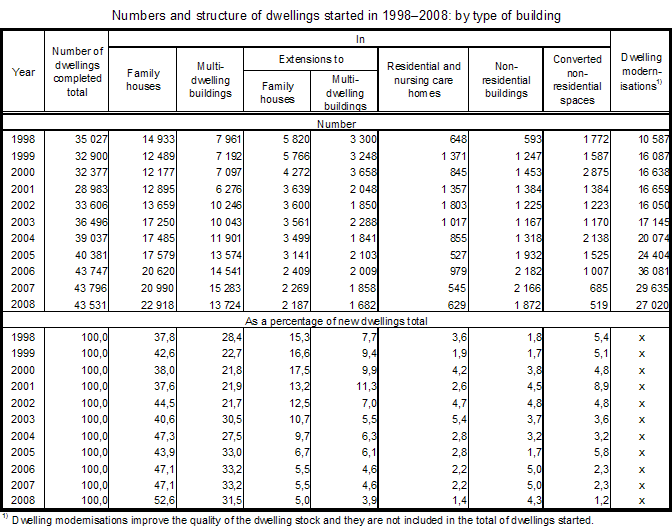
Dwellings under construction are the only section of housing construction that has been steadily increasing since it reached its minimum in 1994. At the end of 2008 there were 176 123 dwellings under construction in the Czech Republic, including those whose construction had been suspended.
Out of the total number of 176 123 dwellings under construction on 31 December 2008, new dwellings in family houses had the largest percentage (50.6%), followed by dwellings in extensions to family houses (18.4%). Due to a considerably shorter construction period of multi-dwelling buildings the percentage of corresponding dwellings under construction was substantially lower, namely 19.0% in new multi-dwelling buildings and 4.5% in extensions to multi-dwelling buildings. The remaining percentage of dwellings under construction fell on the other types of buildings in which new dwellings were being constructed.
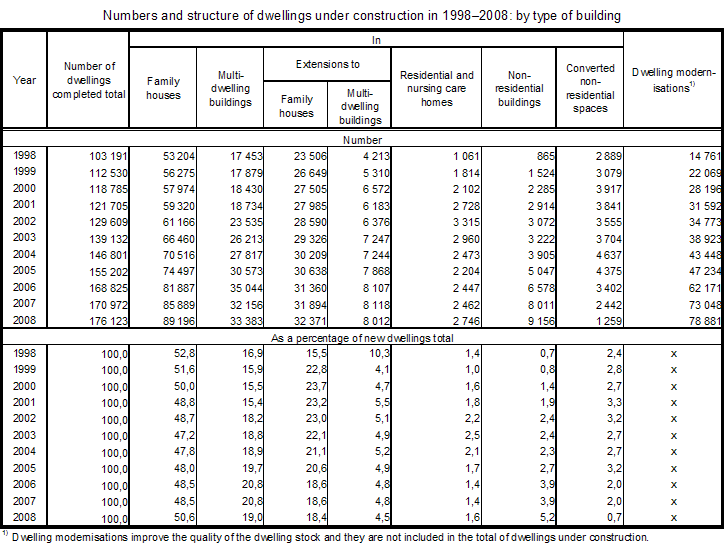
3. Dwelling types
The size of living and useful floor areas of dwellings varied during the years depending on the structure of completed buildings. In 2008 the average living floor area per dwelling was 76.0 m 2 (+8.0%) and the average useful floor area 107.0 m 2 (+8.4%). Considerable differences were recorded for individual types of constructions. While living and useful floor areas per new dwelling in family houses were 93.6 m 2 and 138.8 m 2 respectively, those per dwelling in multi-dwelling buildings were by nearly a half smaller (54.0 m 2 and 71.2 m 2 respectively). Traditionally, the smallest dwellings are built in residential and nursing care homes (living floor area per dwelling not exceeding 30 m 2 and useful floor area 40 m 2).
Dwellings in family houses and multi-dwelling buildings: by number of rooms, 2008
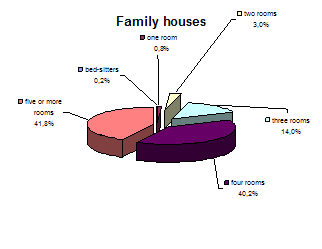 | 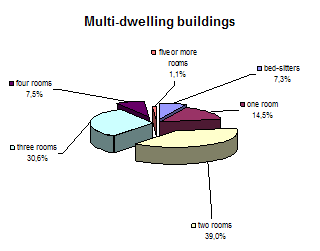 |
The average number of rooms per dwelling differs depending on the type of the building. In total for 2008, dwellings with four rooms plus a kitchen; small one-room dwellings and bed-sitters made up less than 15%. Large dwellings are prevailing in family houses: dwellings with five or more rooms plus a kitchen (41.8%) and dwellings with four rooms plus a kitchen (over 40%); the percentage of bed-sitters and dwellings with one room plus a kitchen is below one per cent. The structure of numbers of rooms per dwelling in the other categories differs. While dwellings with two rooms plus a kitchen prevailed among those built in new multi-dwelling buildings, as extensions to multi-dwelling buildings, dwellings obtained by conversion of non-residential spaces and new dwellings in non-residential buildings, dwellings with three rooms plus a kitchen were most represented in extensions to family houses. Quite a different situation was recorded for dwellings in residential and nursing care homes where dwellings with one room plus a kitchen including bed-sitters prevail.
On average there were 1 dwelling and 2.0 floors per newly completed family house and 20 dwellings and 4.6 floors per multi-dwelling building.
Amenities of dwellings are better year by year. Electricity and water supply coverage is considered 100% and is not observed. Among all dwellings completed in 2008, 64.2% were connected to the gas service, less that one per cent to the local gas tank serving completed constructions or municipality, and 35.2% were unconnected to the gas. The structure of gas connections was similar to that in 2007. Nearly 80% of all new dwellings were connected to the sewerage system, 14% to the septic tank, and 6% of dwellings (predominantly in family houses) had a wastewater treatment plant of their own. Central heating (house or long-distance heating) was installed in 84.8% of all new dwellings; local heating in 12.3% of dwellings and other type of heating was in 3.0% of dwellings. House central heating was put in mostly in family houses; local heating which implies location of boiler or other heating apparatus was put in mainly in dwellings in multi-dwelling buildings.
Bricks and blocks were the mostly used construction materials – for 83.0% of all dwellings completed. The percentage for family houses was 91.4%. Load-bearing structure of bricks and blocks was prevailing in all new dwellings. The percentage of prefabricated constructions continued dropping (from 22.5% in 1997 to 3.0 in 2008). This technology was mostly used for multi-dwelling buildings; and nearly for 13% of all new dwellings obtained by conversion of non-residential spaces. The low percentage of wood constructions remained, being 2.9%. Wood as construction material is used mainly for family houses (5.2% of them are of wood). In comparison with 2007, the share of other materials grew considerably (from 3.0% to 11.1%). In total 77.9% of these materials were used for new dwellings in multi-dwelling buildings, their share in other types of constructions was marginal.
The size of building sites for family houses constantly grew. The average size of a building site increased from 887.6 m 2 in 1997 to 1 098.5 m 2 in 2008. The average size of building site for family houses was roughly the same as in 2007; the average built-up area was 133.6 m 2 as against 143.0 m 2 in 2007. The average building site for new multi-dwelling buildings dropped to 2 057.3 m 2 (-6.0%), and built-up area to 554.0 m 2 (-6.7%).
Construction period was still very long, although it has been slightly decreasing in last years. In 2008 the construction of a family house took 38 months on average, multi-dwelling buildings were completed faster (in 26.8 months). Dwellings in extensions to family houses took the longest construction time (over 5 years).
4. Housing construction by region and municipality
In 2008 most dwellings were built in the Středočeský Region (8 041 dwellings), in Prague (6 328 dwellings) and in the Jihomoravský Region (4 553 dwellings). Compared to 2007, only the Středočeský and Jihomoravský regions swapped top positions, the largest numbers of dwellings are constructed in the above regions in the long term. The fewest dwellings were constructed in the Karlovarský (628 dwellings), Ústecký (993 dwellings) and Zlínský (1 326 dwellings) regions. In Prague the most dwellings were built in multi-dwelling buildings, in all the other regions dwellings in family houses prevailed.
In the long term (1998–2008), the most dwellings were built in large cities – in Prague, Brno, and Plzeň; also in some municipalities in the neighbourhood of Prague, for example Jesenice or Hostivice, where the process of suburbanisation is being demonstrated.
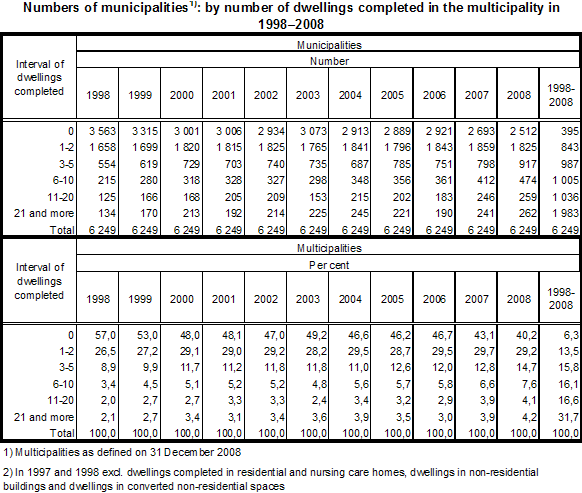
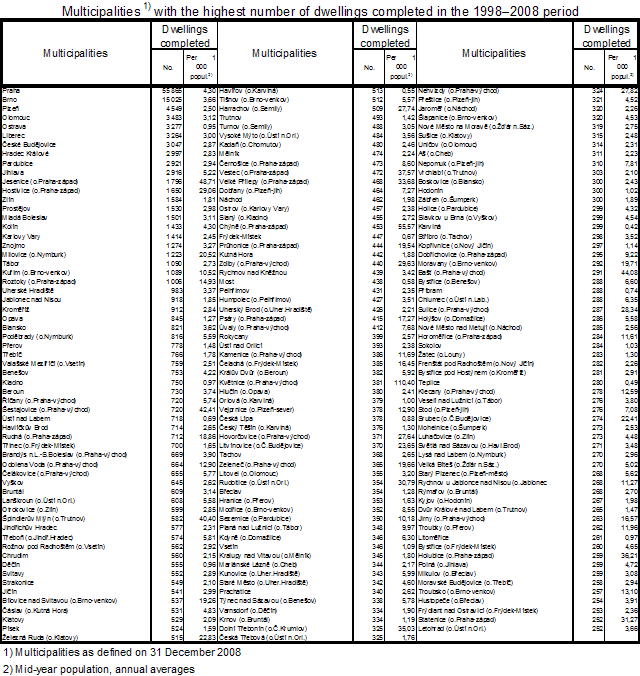
5. Acquisition value of dwellings
One of the most important indicators characterising dwellings completed is the acquisition value. The total acquisition value of dwellings newly completed in the Czech Republic in 2008 was CZK 91.5 billion (+5.7%). The tendency of increasing construction costs continued. The average acquisition value per dwelling grew in all categories of dwellings except dwellings obtained by conversion of non-residential spaces. In 2008 the average acquisition value per dwelling was CZK 3 088.0 million (+6.3%) in a new family house and CZK 1 889.3 million (+4.8%) in a multi dwelling building. However, these figures are not showing differences in the size between respective dwellings in terms of space and area. For this reason it is reasonable to compare categories of dwellings by respective units (m 3 and m 2). The average acquisition value per m 3 was CZK 4 221 (+7.2%) for new family houses and CZK 4 820 (+1.4%) for multi-dwelling buildings. A sharp increase was recorded also for acquisition value per m 2 of both living and useful area, namely in all the categories except new dwellings obtained by conversion of non-residential spaces. The average acquisition value per m 2 of living area of a new dwelling was CZK 31 725 (+6.5%). Increases for dwellings in family houses were 7.2% (new houses) and 8.6% (extensions), for dwellings in multi-dwelling buildings 7.9% (new buildings) and 8.3% (extensions). An increase was recorded also for acquisition value per m 2 of useful area, the value was CZK 22 534 in 2008 compared to CZK 21 263 in 2007 (+5.0%). Increases for dwellings in family houses were 8.2% (new houses) and 5.9% (extensions), for dwellings in multi-dwelling buildings 7.5% (both new buildings and extensions).
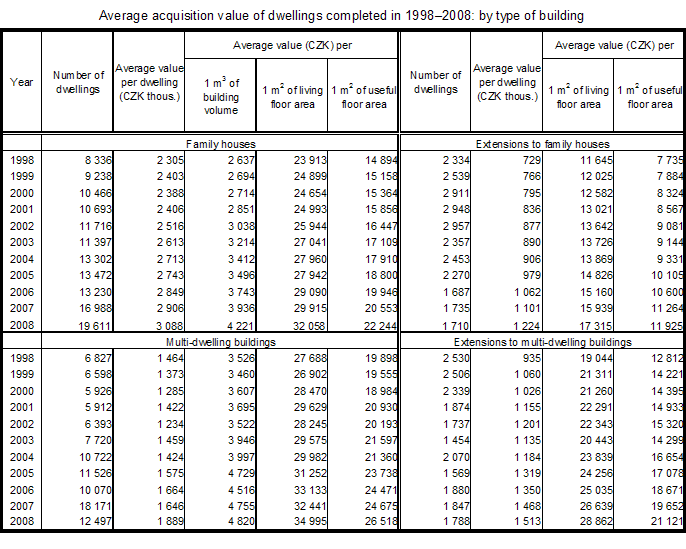
A comparison between regions of acquisition value per m 2 of useful area of newly completed dwellings shows that it is significantly higher in Prague than in the other regions. This holds for dwellings in family houses and in multi-dwelling buildings alike, both new houses/buildings and extensions. Multi-dwelling buildings are an exception – the highest average acquisition value per m 2 of useful area was in the Středočeský Region. The lowest acquisition values of dwellings in multi-dwelling buildings were in the Ústecký Region (both new buildings and extensions) and of dwellings in family houses in the Vysočina Region (new houses) and Moravskoslezský Region (extensions).
